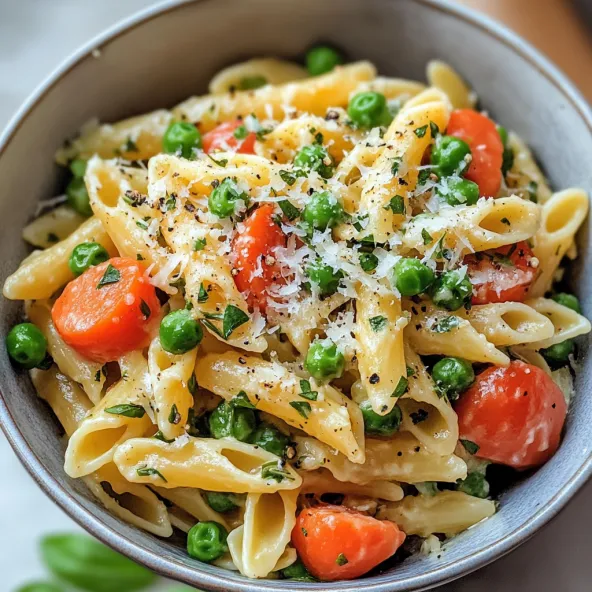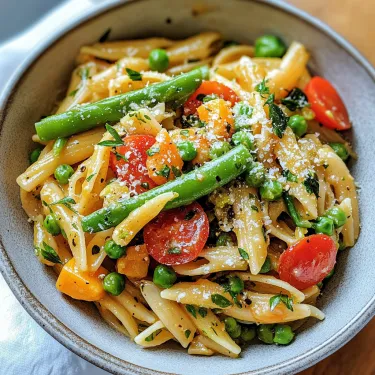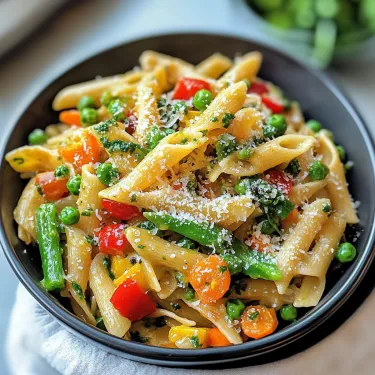 Save
Save
This spring vegetable pasta celebrates the season's bounty with a colorful array of fresh produce in a light, flavorful sauce. Perfect for busy weeknights when you crave something wholesome yet quick to prepare. The combination of tender asparagus, sweet peas, and juicy tomatoes creates a dish that tastes like sunshine in a bowl.
I first created this pasta during a particularly beautiful April evening when the farmers market was overflowing with the first spring vegetables. Now it has become our family's official welcome to spring ritual that everyone looks forward to after the heavy dishes of winter.
Ingredients
- Pasta preferably penne or farfalle catches all the vegetables in their ridges
- Asparagus look for bright green stalks with tight compact tips for the freshest flavor
- Cherry tomatoes select firm ones with vibrant color for the sweetest taste
- Sugar snap peas or green peas both work beautifully choose what looks freshest
- Garlic fresh cloves provide much better flavor than pre minced options
- Butter and olive oil the combination creates a silky base with perfect flavor
- Parmesan cheese use freshly grated for the best melting properties
- Fresh herbs basil and parsley bring brightness that dried herbs simply cannot match
- Lemon zest and juice adds brightness that balances the richness of the cheese
- Red pepper flakes optional but adds a pleasant warmth rather than overwhelming heat
Step-by-Step Instructions
- Boil the Pasta
- Fill a large pot with water add a generous pinch of salt about 1 tablespoon and bring to a rolling boil. Add pasta and cook according to package directions until al dente usually 8 to 10 minutes. Before draining reserve half a cup of the starchy cooking water this is crucial for creating a silky sauce. Drain pasta but do not rinse to preserve the starch that helps sauce adhere.
- Prepare the Vegetables
- While pasta cooks heat olive oil and butter in a large skillet over medium heat until butter is melted and slightly foamy. Add minced garlic and cook for exactly 30 seconds stirring constantly until fragrant but not browned as burned garlic becomes bitter.
- Create the Sauce
- Add asparagus tomatoes and peas to the skillet with the garlic. Sauté for 4 to 5 minutes tossing occasionally. You want the vegetables to soften slightly but maintain their bright colors and slight crispness. Asparagus should bend but still have some resistance when pierced with a fork.
- Combine and Finish
- Add the drained pasta to the skillet with vegetables along with red pepper flakes salt and black pepper. Pour in the reserved pasta water and sprinkle with Parmesan cheese. Toss everything together over medium low heat for about 2 minutes until the cheese melts and creates a light creamy coating on the pasta. Add lemon zest and juice tossing to distribute the citrus flavor throughout.
- Add Fresh Herbs
- Remove the skillet from heat and immediately add the chopped basil and parsley. Toss gently to incorporate the herbs without wilting them too much preserving their fresh flavor and vibrant color.
 Save
Save
My family has a tradition of enjoying this pasta on our patio for the first alfresco dinner of the year. There's something magical about the combination of fresh herbs and that hint of lemon that truly captures the essence of spring in every bite.
Make Ahead and Storage
This spring pasta keeps beautifully in the refrigerator for up to 3 days in an airtight container. The flavors actually develop and meld together overnight making it possibly even more delicious the next day. If serving as leftovers you can enjoy it cold as a pasta salad or gently reheat in a skillet with a splash of water or broth to revive the sauce. Avoid microwaving if possible as it can make the vegetables mushy.
Perfect Substitutions
This recipe welcomes adaptations based on what looks best at your market. Baby spinach or arugula can be added in the final step for extra greens. Fava beans or even blanched green beans work wonderfully in place of peas. For the pasta any medium shape works well including gluten free varieties. The key is selecting a shape that will capture the sauce and small vegetables in its crevices.
Serving Suggestions
Serve this vibrant pasta as a main course alongside a simple green salad dressed with olive oil and lemon juice. For a more substantial meal add grilled chicken breast or sautéed shrimp on top. A glass of crisp Pinot Grigio or Sauvignon Blanc perfectly complements the bright flavors of the dish. Finish the meal with strawberries and cream for a truly seasonal spring dinner.
 Save
Save
Common Recipe Questions
- → What types of pasta work best with this dish?
This versatile dish works well with medium-shaped pastas like penne, farfalle (bow ties), or fusilli that catch the vegetables and sauce. Long pastas like linguine or spaghetti also work beautifully. Choose what you prefer or have on hand!
- → Can I make this dish ahead of time?
Yes! This pasta tastes delicious both warm and cold. You can prepare it up to a day ahead and store it in the refrigerator. If serving cold, it makes an excellent pasta salad. For reheating, add a splash of water or olive oil and warm gently to maintain the vegetables' texture.
- → How can I add protein to this pasta?
For added protein, try incorporating shredded rotisserie chicken, sautéed shrimp, or flaked salmon. Vegetarian options include white beans, chickpeas, or small cubes of pan-fried halloumi cheese. Simply add your protein of choice when combining the pasta with vegetables.
- → Can I substitute frozen vegetables?
While fresh vegetables provide the best texture and flavor, frozen peas and asparagus can work in a pinch. Thaw them first and reduce their cooking time slightly to prevent overcooking. Cherry tomatoes are best used fresh for their juicy texture and bright flavor.
- → What can I use instead of Parmesan cheese?
Pecorino Romano offers a sharper flavor profile, while Grana Padano provides a milder alternative to Parmesan. For a dairy-free version, nutritional yeast provides a cheesy flavor, or try a vegan Parmesan substitute. You can also omit the cheese and add extra lemon juice and olive oil.
- → How do I know when the vegetables are properly cooked?
The vegetables should be tender-crisp—meaning they still have some bite and vibrant color. For asparagus and snap peas, this usually takes 4-5 minutes of sautéing. They should be bright green and easily pierced with a fork, but not soft or mushy.
